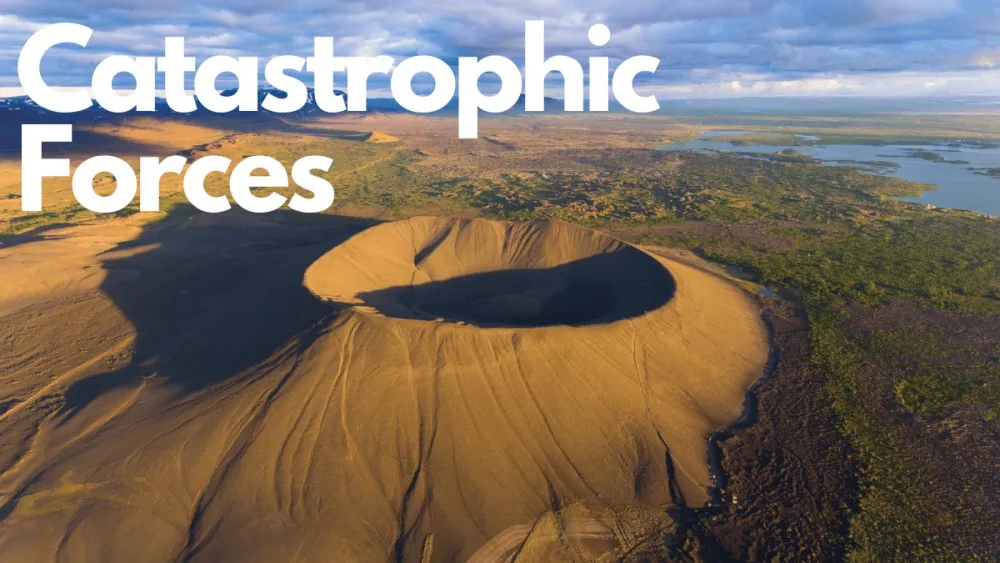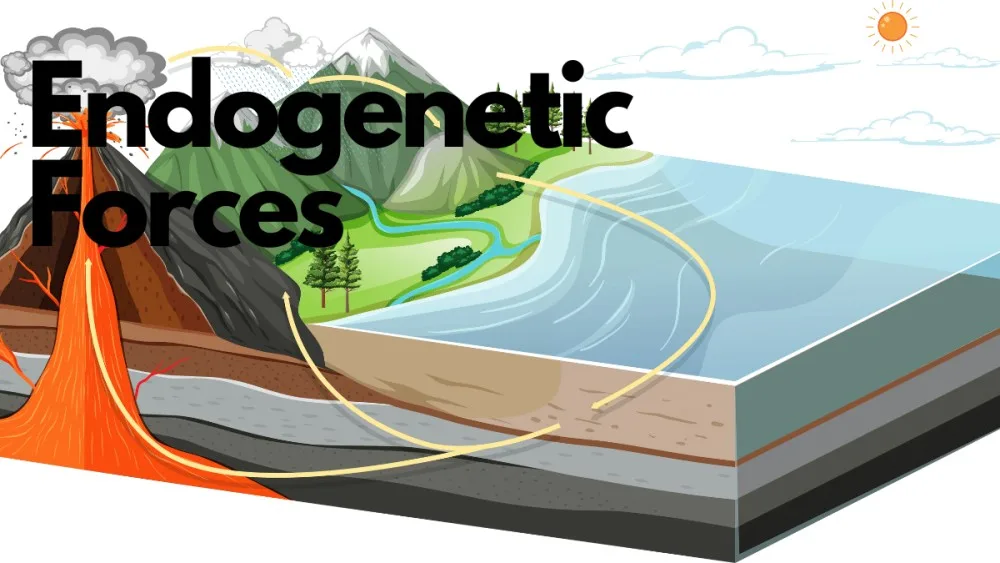ENDOGENETIC FORCES
Endogenetic forces are formed deep inside the earth, These forces are also called constructive forces as these forces are responsible for producing initial surface irregularities on earth in the form of highlands and lowlands. Landforms are classified into three categories based on their size and the processes involved in the formation of landforms:
⦁ First order Landform (Macro landforms: Continents & Oceans)
⦁ Second order Landforms (meso landforms: Mountains, Plateaus & mid-oceanic ridges)
⦁ Third Landforms (Fluvial landforms, Coastal landforms, Glaciated and Arid) are exogenetic forces.
First and second-order landforms are formed by endogenetic forces. Further endogenetic forces are broadly classified into two categories based on their nature of formation and expression. These forces are further divided into the following:

Catastrophic Forces– These are expressed suddenly on the surface of the earth and for a relatively shorter duration of time. Earthquakes and Volcanoes are included in catastrophic forces. Though their expression is sudden and for a shorter duration of time. However, forces are produced and accumulated deep inside the surface of the earth over a long period.
Diastrophic Forces– These are also called secular forces. These are gradual and slow in their scale of operation. this produces changes over a long duration of time on the surface of the earth. These forces are further classified into two categories based on their direction of operation. These forces are further divided into two parts:
Epigenetic movement-(Endogenetic Forces)
These movements are the long radius of the earth. Upward and Downward movement. These vertical movements are broadly classified into two categories: (a) Uplifted and Emergent (b) Subsidence and submergence.
(a) Uplifted & Emergence Landform- if a continental landmass moves upward and changes into a highland. The movement of low continental landmass. if the process of upward movement occurs in the coastal region and inside the sea and the continental block moves above sea level landform is known as an emergence landform. e.g. uplifted landforms are Chotanagpur Plateau and Satpura. An example of an emergency coast is the Malabar coast.
(b) Submergence & Submergence Landform- If the continental block moves downward and is converted into a lowland landform is known as a landform of subsidence. If this process of downward movement occurs in a coastal region and a landform moves below sea level and disappears from the surface it is known as a submergence landform for example, the rift valleys of the Damodar, Narmada, Tapi, and Konkan coasts.
Orogenetic Movement-
These forces work on the surface of the earth or their movement is tangential based on their direction of movement, These forces are further classified into two categories: (a) Convergent forces and (b) Divergent forces.
(a) CONVERGENT FORCE– They work face to face and towards each other These are also called the basis of their intensity Landforms produced by convergent forces are broadly divided into two categories: Crustal Bending or Warping and crustal Folding. Crustal forces are low intensity or gentle in their operation. Based on the direction of movement of the crust and related bending. Crustal bending is classified into two categories: Upbending and Downbending.
Upbending- it produces highland on the surface of the earth, convexity of the earth’s surface is upward.
Downbending- It produces depression on the surface of the earth, and the convexity of the earth is downward.
Folding
Folding occurs in rocks and sediments of compressional forces and are relatively stronger. A wave-like landscape is formed on the surface with upfold and downfold. Upfolds are called anticlines and downfolds are called synclines. Upfold formed the summit of the mountain and downfold formed troughs or river valleys.
If compressional forces are moderate and equal then symmetrical folds are formed. In the symmetrical fold arms of the fold are equal and there is also equal inclination from the axis of the fold. Anticlinorium refers to those folded structures where there are a series of minor anticlines and synclines within one extensive anticline. Synclinorium represents a folded structure that includes an extensive syncline having numerous anticlines and synclines.
The nature of folds depends on the nature of rocks and, the intensity of compressive forces. The elasticity of rocks largely affects the nature and the magnitude of the folding process. Based on the inclination of the limbs, folds are divided following:
(a) Symmetrical Folds- these are simple folds, the limbs of which incline uniformly. These folds are an example of an open fold. Symmetrical folds are formed when compressive forces regularly but with moderate intensity.
(b) Asymmetrical Fold- it is formed when one of the forces is relatively strong. stronger and more intense in respect for another. In asymmetrical fold one of the arms is gently inclined on the surface in respect of another which is shorter and stiff from the surface.
(c) Monoclinal Fold- In a monoclinal fold one of the arms is short and vertical and another is longer and moderate.
(d) Isoclinal Folds- Both arms of the fold are parallel to each other. However, inclined on the surface.
(e) Recumbent Fold- Both arms of the fold are parallel and horizontal.
(f) Overturned Fold- If one of the folds moves over another fold and the arms of the fold are inclined through a parallel fold is called an overturned fold.
(g) Overthrust Fold- One force is completely pressed over another and the arms of the fold are overthrust fold.
(h) Plunge Folds- These are formed when the axis instead of being parallel to the horizontal plane becomes tilted and forms plunge folds.
(i) Fan Folds- represents an extensive fold consisting of several minor anticlines and synclines.
(j) Open Folds- are those in which the angle between the two limbs of the fold. such folds are formed due to wave-like folding because of the moderate nature of compressive force.
(k) Closed Folds- are those folds in which the angle between the two limbs of a fold is acute. Such folds are formed because of intense compressive force.
NAPPIES– If the overthrust fold is further subjected to compressional forces, rocks are stretched beyond the elastic limit. A line of fracture is developed and there is great movement of horizontal arms of fold. This great displacement is called “Nappie”.
DIVERGENT FORCES
These forces are also called tensional forces and are responsible for the stretching thinning fracturing and displacement of rocks. This entire process is called Faulting.
FAULTING– It is the process of movements of rocks due to the accumulation of elastic strain of energy and its release. Faulting is of three types: normal faulting, reverse faulting, and lateral faulting.
Normal faulting- It occurs in the case of tensional forces or divergent forces. The angle of the fold line with the surface is 45 degrees or more.
Reverse faulting- It occurs in a case of compressional forces. The angle of the fault line is below 45 degrees.
Lateral faulting- The movement of rocks is parallel to each other without vertical movement along the fault. Rocks merely pass each other without any vertical movement along the fault.


1 thought on “Endogenetic Forces Dynamic Geological Transformation”